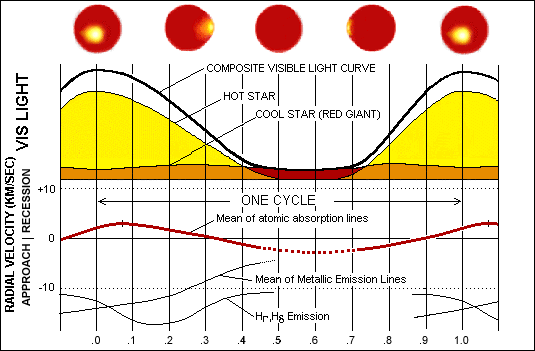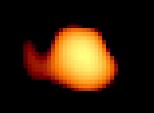|
Following up on Merril's line of thought, I suggest that Miras are, in
fact, close binaries (really close!) where the primary body is typically
a red giant which has a hot main-sequence star orbiting inside/below its
reversing layer. (They could be called Common Envelope Binaries.)
This model may well satisfy the majority of the theoretical
difficulties encountered in trying to interpret the remarkably
rich observational information we have on Miras.
The following figure shows a hot-star orbiting beneath the reversing layer
of a red giant. In this case the orbital plane of the hot-star is such
that for a portion of its orbit it is completely out of sight of the
observer. During this time of eclipse the Mira system will display
a type M spectrum only. (Nebular emission lines in the vicinity of the
red giant may sometimes provide evidence of the hot star's presence even
when it is out-of-sight to the observer.) Merrill summarizes this nebular
material issue with regard to C.O. Lampland's photographs of R Aquarii
taken in 1921. (Merrill, p. 87ff.)

Figure 1. Light and Radial-Velocity Curves for a Typical Mira Variable
(Spectral lines shown are based on data from Alfred H. Joy 1954)
Zero radial velocity (with respect to the binary center-of-mass)
corresponds to approximately 58 Km/Sec Heliocentric in Joy's data.
The solid black line on the light-curve section corresponds to the composite
visible magnitude for both stars. Yellow represents the hot-star
and red represents the red giant's energy in the visible spectrum. (Up to 90
percent or more of the red giant's energy is in the infra-red and is not
represented in this figure.) The orange at the bottom represents the
superposition of the red and yellow.
It has long been surmised that long period variables show evidence of an
outward directed mass flow shortly after maximum light. The Hydrogen and
metallic emission lines provide invaluable information to allow
hydrodynamicists to model this flow. The hot star (hot spot) presumably
heats the overlying layers of the common atmosphere to induce the outward
flow. This flow may create a rooster tail effect whose observables would
be expected to lag behind maximum brightness.
According to the sub-surface orbiting hot star hypothesis the maximum light
of the binary should occur when the hot sub-surface star is closest to the
observer, i.e., between the observer and the red giant's center of mass.
In cases where a hot-star goes into total eclipse, the spectrum of the
red-giant should step-wise brighten during the eclipse. (This is not
stated quite right.) The brightening would probably be more noticeable
in infra-red and at longer wavelengths than in visible light or UV.
At the American Astronomical Society 198th Meeting in June 2001,
R.R. Thompson and M.J. Creech-Eakman presented a paper titled
Departures from spherical symmetry in Mira Variables at PTI. Eight
of ten Miras studied show evidence of a departure from spherical symmetry.
Candidate causes named were: star spots, limb-darkening, binarity and
non-radial pulsation induced outflows.
A Space Telescope Science Institute (STScI) press release titled
Hubble Telescope Measures Diameters of Pulsating Stars reported
that Mira variables aren't round but are egg-shaped.
[STSci-1996-26]
If we consider the red-giant part of the hypothetical binary to be
egg shaped (the hot interior star being the cause of the distortion),
then we should expect to see a quadrapole brightness curve for that
component. It's cross-sectional area, as presented to the observer, will
max out twice during each orbit of the hot star. That is, each time the
hot star is at one of the limbs of the red giant the latter will present
increased cross sectional area to the observer. (Since the red-giant is
the darker of the two in the visible spectrum, these variations may
be a challenge to measure.) The diagram above has been modified to show
this predicted quadrapole effect. (Apologies all the way around
if an infra-red brightness curve quadrapole effect is already documented.)
On page 47 of ref (1), Merrill said,
"The most striking result concerning long-period variables is that during
the light-cycle the variation in total energy is less than one-fiftieth
of the variation in visual intensity." This leads me to think that the
red giant part of LPVs emit as much as 50 X 50 (2500) times more total energy
than the visible energy that reaches the red giant's surface (in our direction) from
hypothetical run-around sun-like sub-surface bodies.
[Added 29 Jul 2017.]
In his article on
Star Luminosity,
Frazier Cain says,
"A red giant may be releasing 1,000-10,000 times the luminosity of the Sun."
[Added 30 Jul 2017.]
If the preceding scenario (two or more stars vice one) comes to be
accepted then a lot of UBV photometry may need to be re-evaluated. (An
underlying assumption in UBV work is that you are working with single stars.)
Where two or more stars with differing spectral profiles co-inhabit a given
volume of space, single star vitals will be of questionable value.)
For a Hubble Space Telescope photograph of the variable Mira which shows
potential evidence of a hot star orbiting inside a red giant, see the
Astronomy Picture of the Day (APOD) for October 11, 1998.
References
(1) Merrill, Paul .W., (1940), Spectra of Long-Period Variable Stars,
University of Chicago Press.
(2) Joy, Alfred H., (1954) Ap. J. Supp. 1, 39.
NADS
Other Links and Recommended Reading
Alfred H. Joy Bibliography [Added 10 Dec 2005.]
|

